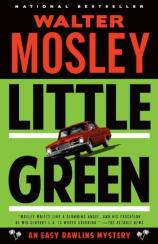Little Green: An Easy Rawlins Mystery
Review
Little Green: An Easy Rawlins Mystery
When we last saw the ironically nicknamed “Easy” Rawlins, he had more or less deliberately driven his car over a precipice to what was almost certainly his ultimate destiny. The finale of what seemed to be Walter Mosley’s final Rawlins novel, BLONDE FAITH, was just ambiguous enough to leave room for his return, should the author have desired such. Some six years later (yes, it has been that long), Easy makes a most welcome return in LITTLE GREEN.
"While Mosley’s bibliography would be enviable whether or not he had chosen to bring back Easy Rawlins, LITTLE GREEN represents a most welcome return for one of detective fiction’s most unique and distinctive characters."
Set in the blooming counterculture of 1967 Los Angeles, LITTLE GREEN begins some two months after Easy’s ill-advised suicide attempt. Easy, whose rescue is worth the price of admission all by itself, regains consciousness surrounded by friends and family, not the least of whom is the seemingly ubiquitous Mouse, who provides Easy with the means and the impetus to quickly rejoin the world, though at a pace that, at least initially, is extremely slow and measured. Mouse requests that Easy undertake a search for a young man named Evander “Little Green” Noon, who has seemingly disappeared into the psychedelic haze of Sunset Strip. He is extremely vague as to his interest in Little Green, which is made all the more mysterious due to the seemingly hostile relationship between Mouse and Timbale, Little Green’s mother.
Timbale doesn’t know much about Little Green’s last whereabouts, other than to note that he was at a hippie club at the invitation of a white woman named Ruby. Easy, possessed of a slender thread of evidence and a supply of what sounds like a voodoo version of a 21st-century energy drink, follows a very vague and complex trail that involves more than Little Green’s disappearance.
While the mystery that gets Easy back on the track of the living is in and of itself certainly interesting enough, LITTLE GREEN is a character-driven work. Easy, who narrates the book in a world-weary first-person past tense, is a veritable library of stories, past and present, and is not afraid to occasionally deviate from the main path of the narrative to relate an incident explaining how this or that character in the story came to be important to him. There are also many vignettes that illustrate what is involved with being a person of color in Los Angeles in 1967.
Mosley, through his best-known creation, makes a number of observations concerning injustice, but these are not limited to those inflicted by whites upon their black neighbors. Rather, he digs deeply into the cracks and crevices of black-on-black crime, as well as the numerous, seemingly minor, yet still important random acts of kindness (and yes, cruelty as well) that strangers of similar circumstance bestow upon each other. It is these secondary, so-called background stories that ultimately separate Mosley’s work in any genre from those of his peers and render his Easy Rawlins novels mandatory reading.
While Mosley’s bibliography would be enviable whether or not he had chosen to bring back Easy Rawlins, LITTLE GREEN represents a most welcome return for one of detective fiction’s most unique and distinctive characters. Here’s hoping that Easy continues to find life worth living for some time to come.
Reviewed by Joe Hartlaub on May 16, 2013





